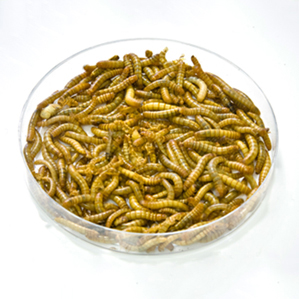Insect Farming Is Taking Shape as Demand for Animal Feed Rises
Most farmers go to great lengths to keep insects at bay. For a growing cadre of livestock and fish producers though, bugs have never been so welcome.

Despite the appearance of some insect-based foods on store shelves—protein bars and tortilla chips made from crickets, for instance—creepy-crawlies are still a little distasteful for most.
However, food producers are likely to feel the pinch as the world’s population climbs to nine billion by 2050, while rising incomes in large countries like China and India lead to greater demand for meat-rich diets. So entrepreneurs, researchers, and even the United Nations are looking for an animal feed less expensive than the soybeans and fish meal typically used today. Insects like mealworms and fly larvae, a natural food for wild birds and fish, could be a near-perfect replacement. With several startups planning industrial-scale operations, it may not be long before some poultry or fish entrées are raised on a regular diet of bugs.
Today 15 percent of all wild-caught fish goes to feeding farmed fish, pigs, or poultry. Soybean production, about 95 percent of which goes into animal feed, has seen a significant spike since the 1990s and will reach record highs this year. But unless yields can be significantly increased, continuing this surge would mean gobbling up additional land and water.
Not only do insects use far less of these resources than soy, but they also feed on food waste. Furthermore, they’re comparable to soy in protein content. Breeding trials conducted by the E.U. initiative PROteINSECT have found that one hectare of land could produce at least 150 tons of insect protein per year. By comparison, soy planted over the same area yields just under a ton of protein per year.
Feeding trials also suggest that a bug-based diet will produce bigger, stronger livestock. In its 2013 report on edible insects, the Food and Agriculture Organization of the U.N. pointed to several studies on fish and Japanese quail in which ground crickets replaced up to 50 percent of the fishmeal in their feed. The fish outperformed counterparts fed traditional diets on every growth parameter, and the cricket-fed quail laid more eggs than the control group.
Nevertheless, the industry is still in its infancy. Reaching industrial-scale production is the next step, and new technology will need to play a role.
Enterra Feed, a Vancouver company making insect-based feed and fertilizer, expects to complete work this month on a largely automated production facility that can take in 100 tons of pre-consumer food waste per day to feed its army of black soldier flies. The larvae are grown in shallow trays with sensors that track the time and content of automatic feedings. Technicians use that data, along with temperature readings, to determine when to harvest the larvae so that their protein and fat content is at its peak.
The company hopes to get regulatory approval for its products early next year and is exploring possible expansion in Seattle, San Francisco, and Toronto.
Protix Biosystems, based in Amsterdam, plans to start delivering to a feed company next year, although existing regulations currently restrict it to producing its insect-based feeds for research purposes only. “The concept of the insect as a protein source is something nature already evolved to perfection,” says cofounder Kees Aarts. “We just need scalable technologies.”
Another company, Ynsect, a startup outside Paris, plans to build what it says will be the world’s first fully automated large-scale insect production facility, capable of producing 10,000 tons of dried protein meal, liquid fat, and chitin-derived products from insects each year. Construction will begin in 2016.
Companies are tight-lipped on the projected cost of their insect-based animal feed, but most told MIT Technology Review that it would fall between the prices of the two products the feed aims to replace: soy meal and more expensive fish meal.
“The technology has been proven. The proof of concept is there,” says Sonny Ramaswamy, director of the USDA’s National Institute of Food and Agriculture, which has awarded three small-business research grants to companies exploring insects as food since Ramaswamy, an insect physiologist by training, came into office.
Despite such enthusiasm, regulatory hurdles remain. In the United States, only a few states allow insect-based feed in commercial poultry or aquaculture, although regulatory approval for wider use could come next year. E.U. regulators are waiting for more extensive human health and safety data, but discussions are ongoing about opening up the aquaculture industry to insect feedstock.
Keep Reading
Most Popular
Large language models can do jaw-dropping things. But nobody knows exactly why.
And that's a problem. Figuring it out is one of the biggest scientific puzzles of our time and a crucial step towards controlling more powerful future models.
The problem with plug-in hybrids? Their drivers.
Plug-in hybrids are often sold as a transition to EVs, but new data from Europe shows we’re still underestimating the emissions they produce.
Google DeepMind’s new generative model makes Super Mario–like games from scratch
Genie learns how to control games by watching hours and hours of video. It could help train next-gen robots too.
How scientists traced a mysterious covid case back to six toilets
When wastewater surveillance turns into a hunt for a single infected individual, the ethics get tricky.
Stay connected
Get the latest updates from
MIT Technology Review
Discover special offers, top stories, upcoming events, and more.